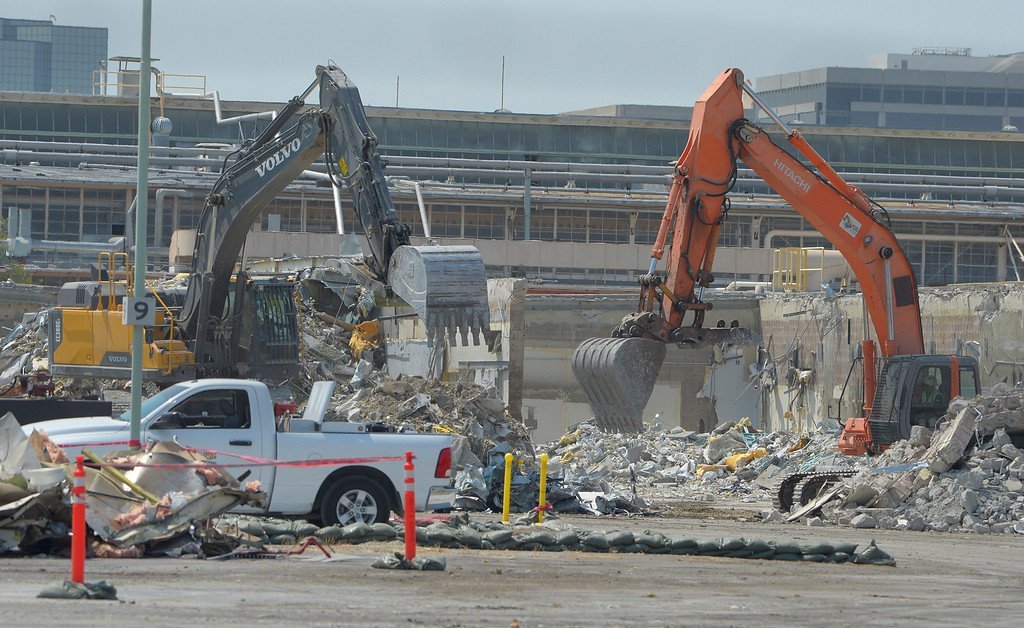
It built rocket engines strong enough to breathe fire into Gemini, mighty enough to blast Apollo to the moon and sturdy enough to launch 135 space shuttle missions without ever casting an astronaut adrift. Now the 61-year-old Rocketdyne Propulsion & Power plant in Canoga Park, once home to tens of thousands of San Fernando Valley […]

It built rocket engines strong enough to breathe fire into Gemini, mighty enough to blast Apollo to the moon and sturdy enough to launch 135 space shuttle missions without ever casting an astronaut adrift.
Now the 61-year-old Rocketdyne Propulsion & Power plant in Canoga Park, once home to tens of thousands of San Fernando Valley scientists, engineers and engine makers, is being demolished.
“Another bit of Valley history bites the dust,” said Martin M. Cooper, author of “Read All About It!,” a history of the postwar Valley. “That facility was one of several hubs in the Valley that took us from creating military airplanes in World War II, to commercial planes afterward, to rocketry and space travel.
“It’s really a shame there’s no way to properly commemorate that, saying “Something worth remembering happened here.’ ”
For the past week, backhoes and front loaders have been ripping down the north side of the abandoned rocket engine plant during a demolition expected to take nine months to a year.
The 46-acre complex, shuttered by Aerojet Rocketdyne a few years ago, is slated to be transformed by owner United Technologies Corp. into a $3 billion “sustainable urban neighborhood.”
Until then, the company and its developers will work with local and state agencies during an environmental cleanup that includes asbestos and soil removal and disposal of decades of contaminated concrete.
When the giant Space Age buildings taking up nearly the entire block between Victory Boulevard and Vanowen Street are razed, UTC developers will move toward constructing a proposed L.A. Warner Center.
Where up to 23,000 Rocketdyne engineers once toiled will stand an urban village of boutiques, offices, hotels and as many as 4,000 residences. The area is increasingly populated by high-rise condos.
A representative for Boston Global Investors, the development consultant hired by UTC to develop an L.A. Warner Center Master Plan, was not able to comment Thursday. Brad Rosenheim, a Woodland Hills-based land-use consultant hired by UTC, did not return calls.
Flash back to the close of World War II, when America wanted missiles for its military and rocket engines in which to power them.
To win the arms race with the Soviets, North American Aviation employed a small army of German rocket scientists. Scouts for the defense contractor secured a rocket engine test site in the Santa Susana Mountains far above the scented orange groves of the San Fernando Valley.
In 1955, five years after the rumble of its first rocket test of an engine modeled on what had launched the V-2 missile that had once terrorized England, its Rocketdyne division built the behemoth engine plant in Canoga Park.
Its highly paid engineers, armed with slide rules and some of the keenest minds in the nation, built engines for the Navaho, Redstone and Atlas programs, which launched Mercury, Gemini and Apollo.
At its loudest was the colossal F-1 rocket engine, which powered the first stage of the Saturn V. Standing at 19 feet high and more than 12 feet wide, the engine delivered 1.5 million pounds of thrust.
It took five mighty F-1s inhaling a mixture of kerosene and liquid oxygen to launch the 6.2 million pound Saturn V toward the moon. At blastoff, the thrust equalled the might of more than 85 Hoover Dams.
Of its 13 Apollo missions from 1967 to 1973, 24 astronauts escaped Earth’s orbit without a hitch.
And when NASA wanted a re-usable engine for its space shuttle, it looked to Rocketdyne to build its space shuttle main engine. Failure was not an option. It would power 135 space shuttle missions — composed of a 220,000-pound orbiter and 25 tons of gear — without a loss of life.
Stan Opatowsky got the space bug when he was a boy in Brooklyn. In 1936, he heard a loud rumble over his house. So he raced out only to see an ill-fated German Zeppelin airship.
“The sky was filled with the Hindenburg,” said Opatowsky, 85, of Woodland Hills. “The vertical tail had the red banner, white circle and swastika.”
The young boy grew up to work at Reaction Motors, the nation’s first rocket engine maker, in New Jersey, building the engine that helped propel Brig. Gen. Chuck Yeager to break the sound barrier over the Mojave.
In 1957, he got a job as a development engineer at Rocketdyne in Canoga Park surrounded by fields and orchards, building the vernier engines that would power Atlas and Thor.
“This was one of the prime aerospace companies in the country,” said Opatowsky, who went on to work 30 years for the U.S. Navy in Point Mugu. “Large engines were only built by two companies, Rocketdyne and Aerojet. It’s engines sent our rockets to the moon.
“A lot of people who worked there were very devoted to their jobs. They did great things,” he said. “How many fellas are still around that worked there? Not many. We’re dying off.”